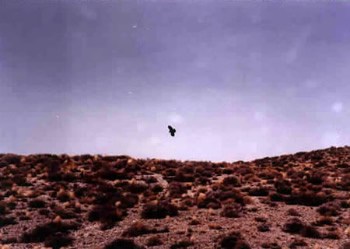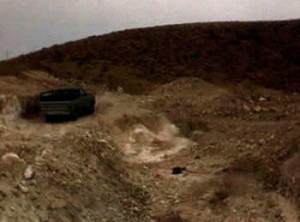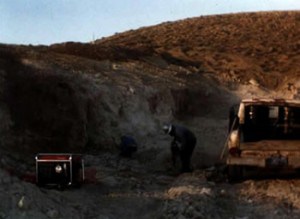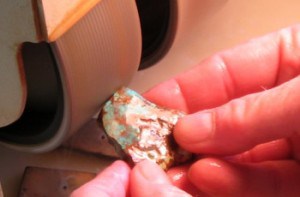
1980s at Stone Mountain Mine
Stone Mountain Mine is located on the western side of Nevada in Lyon County. This is a region that contains the right mineral combinations for turquoise formation within a matrix of interconnected and ancient rhyolitic tufts with small bodies of granodiorite, monzonite, feldspar and andesite scattered throughout the mountain ranges.
This combination of geologic history and rich mineralization attracted a hoard of pioneers and prospectors in the late 1800’s. The hills surrounding today’s Mason Valley received increasing visitations by the surveyor or prospector looking for significant geologic resources.
The Mason Valley area is dominated by volcanism and is part of a vast string of volcanic calderas called the Long Valley caldera complex. Mason Valley is situated in the far north end of the caldera complex and the surrounding hills and small ranges make up the caldera rim. Adjacent to the region are larger mountain ranges located to the west. The Sierra Nevada mountains are the largest range that sit to the west and have stark contrasting ecology and weather.
 The first explorers that visited the area had to battle the elements. The lack of water and food with almost no shelter made exploration of the area, dangerous and short lived. Even today careful planning is necessary when venturing out into the region. The summer’s are intolerably hot and the winter’s are… frozen. In winter the ground freezes into natural cement-like clumps, making digging nearly impossible.
The first explorers that visited the area had to battle the elements. The lack of water and food with almost no shelter made exploration of the area, dangerous and short lived. Even today careful planning is necessary when venturing out into the region. The summer’s are intolerably hot and the winter’s are… frozen. In winter the ground freezes into natural cement-like clumps, making digging nearly impossible.
The lowlands in the mason valley region area were once covered by Lake Lahontan. Lake Lahontan was an inland sea that covered most of the great basin in the western United States in ancient times. The waters of Lake Lahontan left there mark within the hills of the Long Valley caldera complex by adding silica and concentrations of mineral clays that seeped into the cracks of the rhyolitic tufts that run north to south. These rhyolitic tufts are said to have been created at least a million of years ago after a series of violent upheavals as the Pacific plate bumped into the North American continent.
The mineralized hills surrounding Mason Valley are in a rain shadow of the Sonora, Carson and Yosemite ranges of the Sierra Nevada Mountains. The closest mountains are the Sweetwater and Pine Nut Mountains. These ranges are smaller, however they extend the rain shadow farther into the Great Basin past Mason Valley to the eastern mountain ranges in the center of the state.

a resident hawk
When the Nevada became a state in 1864 there had already been a considerable boom and bust on almost every mountain range all the way from the Spring Mountains in the south, northward to the Idaho border. Every dry creek and trickling spring was accompanied with tents and prospectors of every kind from all over the world. By 1880 the Comstock gold and silver boom began to fade, driving more interest into copper and other metals. Large copper bodies had been discovered in the mid to late 1800’s on the west side of Mason Valley. This brings us to the discovery of turquoise in the vicinity of Stone Mountain Mine. A variety of prospectors and miners have come across the turquoise deposits since the 1890’s copper explorations.
There were a few notable miners who once owned the claims in the Stone Mountain Mine vicinity. Namely “Otto Taubert”, Otto Taubert had likely made the first discovery of today’s Stone Mountain Turquoise while working for a local copper company. Otto Taubert sold his claims to “Walter Godber”. This is the same Walter Godber of the legendary “Godber-Burnham” turquoise claim that later made him famous. It is said that Godber found about $50,000 worth in turquoise before moving onto the better known Godber-Burnham claim in central Nevada.

Stone Mountain Mine in the 1980’s
Otto Taubert located several turquoise deposits in the area including the three “Harcross” claims, later named by F.B. Cross and J.J. Harrison. It is hard to tell which, but one the Harcross claims is most likely to be Stone Mountain Mine. The area that encompasses Stone Mountain Mine has been claimed, dropped and reclaimed by different entities throughout it’s entire history.
In the 1970’s a copper corporation named Anaconda prospected the entire area, leaving shallow trenches on almost every mound, hill or mountain in the area. Anaconda eventually vacated their enterprise leaving the claim abandoned, Suzanne Moore and T. Kevin Cassidy first discovered some turquoise on the claim in the late 1970’s while rockhounding with friends. In 1980 they claimed the deposit with partners, naming it “Stone Mountain Dig”.
*Records previous to the 1960's are not available online. On the Lyon County website the Assessor documents list owners of the Stone Mountain Claim as follows: Claim Name Date Doc Type HARCROSS - 08/31/72 MINING LOC MAP HARCROSS - 10/26/78 AFF/ANNUAL ASSESSMENT HARCROSS - 10/04/79 AFF/ANNUAL ASSESSMENT HARCROSS - 10/29/80 AFF/ANNUAL ASSESSMENT STONE MOUNTAIN DIG - 12/23/80 NOTICE/LOCATION (Suzanne Moore, T. Kevin Cassidy & Partners claim the deposit) STONE MOUNTAIN DIG - 02/10/82 NOTICE/LOCATION STONE MOUNTAIN DIG - 09/12/83 NOTICE/LOCATION (Partners drop from the claim) STONE MOUNTAIN DIG - 09/18/84 AFF/ANNUAL ASSESSMENT STONE MOUNTAIN DIG - 09/03/85 AFF/ANNUAL ASSESSMENT STONE MOUNTAIN DIG - 08/28/86 AFF/ANNUAL ASSESSMENT STONE MOUNTAIN DIG - 09/04/87 AFF/ANNUAL ASSESSMENT STONE MOUNTAIN DIG - 09/07/88 AFF/ANNUAL ASSESSMENT STONE MOUNTAIN DIG - 09/25/89 AFF/ANNUAL ASSESSMENT STONE MOUNTAIN DIG - 09/20/90 AFF/ANNUAL ASSESSMENT STONE MOUNTAIN DIG - 08/23/91 AFF/ANNUAL ASSESSMENT STONE MOUNTAIN DIG - 09/21/92 AFF/ANNUAL ASSESSMENT STONE MOUNTAIN - 09/10/93 CERT/LOCATION (The Cassidy's change the name of the claim) STONE MOUNTAIN - 08/29/94 AFF/ANNUAL ASSESSMENT STONE MOUNTAIN - 08/23/95 AFF/ANNUAL ASSESSMENT STONE MOUNTAIN - 10/10/96 AFF/INTENT/HOLD STONE MOUNTAIN - 09/19/97 AFF/ANNUAL ASSESSMENT STONE MOUNTAIN - 09/02/98 AFF/ANNUAL ASSESSMENT STONE MOUNTAIN - 09/03/99 AFF/ANNUAL ASSESSMENT STONE MOUNTAIN - 09/22/00 AFF/ANNUAL ASSESSMENT STONE MOUNTAIN - 09/18/01 AFF/ANNUAL ASSESSMENT STONE MOUNTAIN - 09/04/02 AFF/ANNUAL ASSESSMENT STONE MOUNTAIN - 09/12/03 AFF/ANNUAL ASSESSMENT STONE MOUNTAIN - 09/10/04 AFF/ANNUAL ASSESSMENT STONE MOUNTAIN - 08/25/05 AFF/ANNUAL ASSESSMENT STONE MOUNTAIN - 09/07/06 AFF/ANNUAL ASSESSMENT STONE MOUNTAIN - 08/14/07 AFF/ANNUAL ASSESSMENT STONE MOUNTAIN - 08/22/08 AFF/ANNUAL ASSESSMENT STONE MOUNTAIN - 08/13/09 AFF/ANNUAL ASSESSMENT STONE MOUNTAIN - 08/27/10 AFF/ANNUAL ASSESSMENT STONE MOUNTAIN - 08/22/11 AFF/ANNUAL ASSESSMENT STONE MOUNTAIN - 03/22/12 DEED (Entree Gold purchases the claim from T. Kevin Cassidy) STONE MOUNTAIN A - 08/03/12 NOT/INTENT/HOLD STONE MOUNTAIN A - 08/08/13 NOT/INTENT/HOLD
*This is a shortened list that shows only one item per year, if you wish
to see all the records, go to http://lyon-county.org then click on the
Assessor page to search their records.

Stone Mountain Mine in the 1980s
In 1982 their partners had all left the operation to Suzanne and Kevin who had sole ownership of Stone Mountain Dig. Within the period of 1982 through 1986 they decided to rename the claim, “Stone Mountain Mine”. After attempting various methods to extract the turquoise from the heavy, iron and quartz laden hostrock, the best methods proved to be the use of hand tools. Picks, pry bars, chisels and garden hoes were the tools of choice except for an occasional air hammer. Explosives were never used and at the time heavy equipment was used only on a few occasions.
In 2001 the Cassidy’s youngest son, Canyon created their first website and soon after the hobby turned into a business. The business was to be named “Nevada Cassidys” Between the years 2001 to 2011 the Cassidy family spent a large amount of time sitting on the dusty rock strewn slopes of the Stone Mountain Mine scanning the sun dried earth for “glass”(a slang term for turquoise veins).
None of the turquoise discovered at Stone Mountain Mine was ever stabilized. Stone Mountain Turquoise is typically hard and does not need stabilization. In 2011 the family adventure ended as in Suzanne and Kevin parted ways and by March 2012 T. Keven Cassidy had sold Stone Mountain Mine to Entree Gold, a mineral exploration company. What may seem like a sad ending to the tale, might actually be a fitting addition with to the history of Stone Mountain Mine. A claim that has changed hands since it was discovered.
Entree Gold has already churned over and the claim is currently held by another, Mason Resources Corp. but for how long? Nearby the Stone Mountain Turquoise deposit mining assessment for copper has already taken place for large portions of the region. There is a considerable copper and molybdenum deposit to the southeast of Stone Mountain Mine called the Ann Mason Porphyry Deposit.
The Ann Mason Copper lode was discovered around the same time that Otto Taubert prospected his turquoise claims. With newer technology and the possibility of large industrial scale mining there, the hope remains that mining will not pit the Stone Mountain Mine vicinity. The small turquoise deposits that are closer to the Anne Mason Copper lode are all in threat of being hauled away, crushed and milled for copper and other minerals. The Anne Mason copper lode is deep underneath the shallow turquoise clusters on the surface there.

Currently, Nevada Cassidys are producing finished turquoise from their collection that came from their time spent digging out in the desert. Without a mine to work the focus has changed to lapidary arts.
